Moroccan Baked Halibut Recipe | Flaky, Spiced & Easy
Baked Halibut Recipe — A Twist of Heritage & Simplicity
Let’s be honest: most baked halibut recipes out there taste… fine. Some are buttery, others lemony, a few come with panko. But if you’re looking for something that actually stands out — not just another “healthy weeknight dinner” — you’re in for something different.
This Moroccan-inspired baked halibut recipe combines the delicate flakiness of wild halibut with warm spices like cumin and paprika, the briny kick of olives, and just a hint of preserved lemon zest. It’s clean, light, yet deeply flavorful — bridging Mediterranean freshness with Moroccan soul.
Whether you’re a busy parent looking for a no-fuss 30-minute meal, a seafood lover chasing new flavor profiles, or someone just bored of the usual garlic-butter routine — this recipe gets it. NOAA Fisheries (U.S. Halibut profile)
And don’t worry: all ingredients are pantry-friendly and globally accessible (Whole Foods, Trader Joe’s, or your local store). Oh, and you don’t need a tagine or clay pot. Just a good oven and a baking dish — we’ll talk tools later.
Let’s get that fish in the oven, shall we?
Why You’ll Love This Moroccan Baked Halibut
Here’s what makes this baked halibut recipe a keeper in any kitchen:
- It’s not boring.
The spice profile (ras-el-hanout, cumin, garlic, paprika) brings a warm, smoky complexity that typical lemon-dill halibut recipes just don’t have. - It’s healthy but satisfying.
Packed with lean protein, Omega-3s, and zero cream or heavy sauces — yet every bite feels rich thanks to olive oil and baked aromatics. Harvard School of Public Health – Omega-3 Benefits - It works with YOUR pantry.
Whether you have jarred olives, preserved lemons, fresh parsley, or just dried spices — this recipe adapts. - One dish, no stress.
Just marinate, bake, garnish. Minimal prep, minimal dishes. Great for weeknights or lazy Sundays. - It’s a cultural fusion that works.
Inspired by the coastal cuisines of Morocco and the Mediterranean, this halibut recipe tastes both familiar and exciting. - It’s impressively easy.
Even if you’re not a fish-cooking pro, this method is forgiving. The spices do the heavy lifting — you just need to not overbake.
This post contains affiliate links. As an Amazon Associate, I earn from qualifying purchases.
Table of Contents
Recipe Details
- Prep Time: 15 minutes
- Cook Time: 15 minutes
- Total Time: 30 minutes
- Servings: 4
- Calories per serving: ~320 kcal
Ingredients You’ll Need for This Moroccan Baked Halibut Recipe
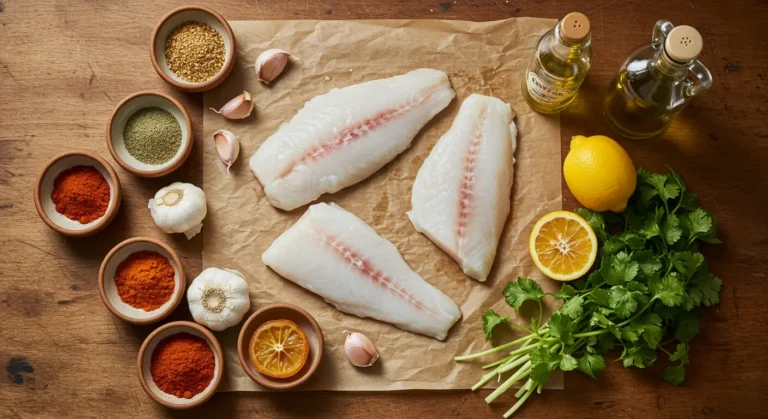
This baked halibut recipe balances freshness, warmth, and subtle Moroccan depth — all using globally accessible ingredients. You don’t need to hunt down anything obscure, but if you’re lucky enough to have a local spice shop or Middle Eastern grocer nearby… you’ll level up the flavor, no question.
The Essentials:
- Halibut fillets – 4 pieces (6 oz each), skin removed.
(Fresh is ideal, but frozen and thawed works too — just pat dry thoroughly.) - Extra virgin olive oil – 2–3 tablespoons.
(Look for cold-pressed, Moroccan or Mediterranean origin if possible.) - Garlic – 3 cloves, finely minced.
- Fresh lemon juice – from 1 lemon
(Optional: swap with preserved lemon rind for deeper Moroccan flavor). - Salt & pepper – to taste.
Moroccan Spice Mix:
- Cumin – 1 tsp
- Sweet paprika – 1 tsp
- Coriander powder – ½ tsp
- Turmeric – ¼ tsp (for color & subtle earthiness)
- Ras el hanout – ½ tsp (optional but powerful)
- Chili flakes or harissa paste – to taste (if you like some heat)
Moroccan Foodie – Guide to Ras el Hanout
TIP: You can mix these into a paste with olive oil and rub over the fillets before baking.
Optional Moroccan Finishing Touches:
- Preserved lemon rind – finely diced
- Pitted green or black olives – chopped
- Fresh cilantro or parsley – for garnish
- Thinly sliced red onion – for color and crunch
- Cherry tomatoes – halved, roasted alongside the fish
Substitutions:
- No halibut? Try cod, sea bass, or even salmon.
- No preserved lemon? Add lemon zest + a dash of sea salt.
- No ras-el-hanout? A combo of cinnamon, ginger, cumin, and coriander works well.
Can I use frozen halibut for this recipe?
Yes, absolutely.
Just make sure it’s fully thawed and patted dry with paper towels before seasoning. Excess water will dilute the spices and steam the fish instead of roasting it.
How to Make This Moroccan Baked Halibut Recipe (Step-by-Step)
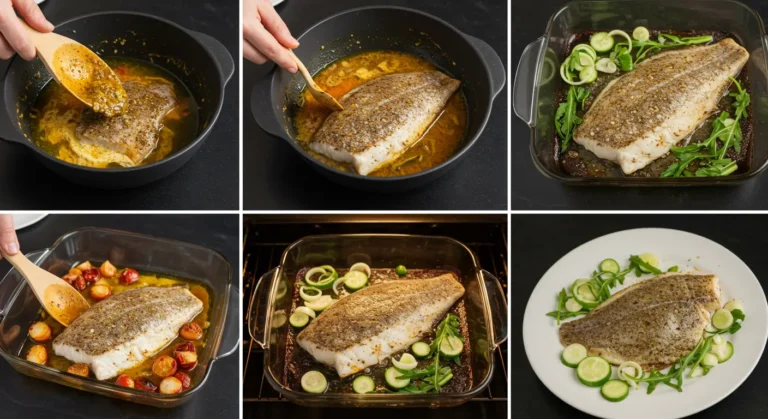
This baked halibut recipe is simple enough for weeknights, but layered with Moroccan-inspired flavors that make it feel restaurant-level. You’ll marinate the fish briefly, bake it until flaky, and finish with bright toppings that scream freshness.
Here’s how to bring it all together:
Step 1: Prep the Marinade
In a small bowl, combine:
- 2–3 tbsp olive oil
- Juice of 1 lemon (or 1 tsp diced preserved lemon rind)
- 3 minced garlic cloves
- 1 tsp cumin
- 1 tsp paprika
- ½ tsp coriander
- ¼ tsp turmeric
- Salt + pepper to taste
- Optional: ½ tsp ras-el-hanout or a small pinch of cinnamon
Whisk well until emulsified.
TIP: For deeper flavor, add a spoon of harissa paste for a spicy, smoky punch.
Step 2: Marinate the Halibut
- Place the halibut fillets in a shallow dish or ziplock bag.
- Pour the marinade over the fillets, making sure each piece is coated.
- Let sit for 15–30 minutes at room temperature.
(You can also refrigerate up to 2 hours for a deeper infusion.)
Step 3: Preheat & Prep for Baking
- Preheat your oven to 400°F (200°C).
- Line a baking dish with parchment or lightly grease it with olive oil.
- Arrange the fillets in a single layer.
(Optional: Add cherry tomatoes, olives, and red onions around the fish.)
Step 4: Bake
- Bake for 12–15 minutes, depending on thickness.
- The fish is done when it flakes easily with a fork and is opaque all the way through.
- Internal temp should reach 135–140°F for perfect texture.
TIP: Don’t overbake — halibut dries out quickly. You want it tender, not chewy.
Step 5: Garnish & Serve
Remove from the oven and top with:
- Chopped parsley or cilantro
- Chopped preserved lemon (or a final squeeze of fresh lemon)
- Optional: extra drizzle of olive oil or harissa for heat
Serve hot alongside couscous, roasted veggies, or Moroccan-style potatoes.
Can I bake halibut in foil instead?
Yes!
Wrap each fillet in its own foil pouch with marinade and veggies. Bake at 400°F for 15–18 minutes. This method locks in moisture and makes cleanup a breeze.
Essential Kitchen Tools for the Perfect Baked Halibut
(Handpicked & Tested – With Affiliate Links)
Cooking the perfect baked halibut recipe isn’t just about the ingredients — it’s also about using the right tools that make your job easier, cleaner, and way more fun. Here are the kitchen essentials I personally recommend (and yes, I’ve handpicked options that are affordable, durable, and Amazon-approved):
- 1. CAROTE 31‑Piece Nonstick Cookware Set
- A sleek, high-performance cookware set with wood-look handles and nonstick interiors — perfect for searing halibut or prepping your preserved lemon sauce.
Shop it on Amazon
- 2. COSORI Smart 12-in-1 Air Fryer Toaster Oven
- Want a crispy, juicy halibut without heating your full oven? This all-in-one air fryer oven does it all — bake, broil, roast, dehydrate — and it’s big enough for family-size meals.
Shop it on Amazon
- 3. Ninja MC1101 Foodi 8-in-1 Cooker
- Ideal for prepping side dishes like couscous or zaalouk while your halibut bakes. This cooker replaces 10 kitchen tools and offers precise temp control.
Shop it on Amazon
- 4. CAROTE Magenta 15‑Piece Cookware Set
- Same performance as the black CAROTE set, but in a bold, modern pink for stylish cooks.
Shop it on Amazon
- 5. Gotham Steel 20‑Piece Ceramic Cookware + Bakeware Set
- If you’re a batch-cooker or love having bakeware variety, this set offers deep pans, muffin trays, and more — all oven & dishwasher safe.
Shop it on Amazon
- 6. Chefman 6-Quart Dual Basket Air Fryer
- For those who love extra-crispy finishes, this air fryer lets you cook halibut and a side (like spiced potatoes) simultaneously with synced timers.
Shop it on Amazon
- Pro Tip:
- If you’re just starting out, one baking dish + a thermometer is enough. But investing in these tools pays off in consistency, flavor — and confidence in the kitchen.
Tips & Tricks for Cooking the Perfect Baked Halibut
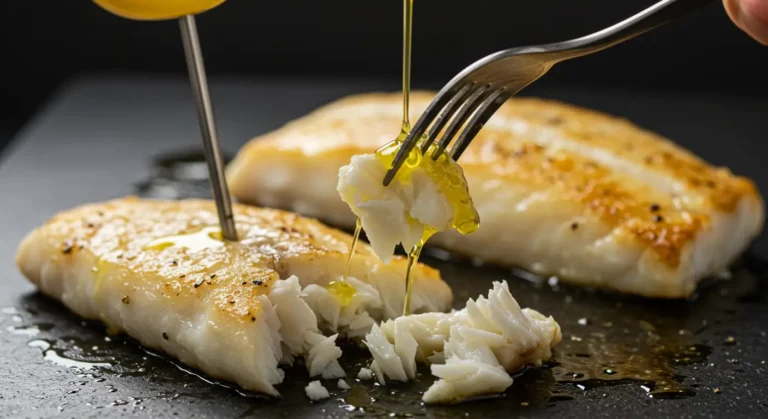
Even a beautifully seasoned baked halibut recipe can go sideways if the technique’s off. Halibut is lean and delicate — which means it needs a little attention to stay juicy and flavorful.
These tested tips will help you avoid the common “rubbery fish” tragedy and get a flaky, tender result every time.
1. Don’t Overbake (Seriously)
Halibut turns from buttery to bone-dry in a matter of minutes. Set a timer. Check early.
Target internal temp: 135°F (carryover cooking will take it to 140°F).
2. Pat It Dry First
Whether using fresh or thawed fillets, moisture on the surface prevents browning and thins the marinade. Use paper towels to dry the fish before marinating.
3. Use High-Quality Olive Oil
It’s the base of your flavor — don’t cheap out. A bold Moroccan or Mediterranean EVOO enhances everything, especially when drizzled after baking.
4. Let the Fish Rest
Just like steak, let the halibut rest 2–3 minutes after baking. This allows juices to redistribute and flavor to deepen.
5. Layer in Flavor, Not Just Spice
Halibut is neutral — it benefits from acidity (lemon, preserved lemon), richness (olive oil, harissa), and freshness (cilantro, red onion). Use all three zones.
Bonus Trick: Quick Moroccan Compound Butter
Mix softened butter with minced garlic, cumin, paprika, lemon zest, and chopped parsley. Freeze in small discs and melt over baked halibut right before serving.
How do I keep halibut from sticking to the pan?
Use parchment paper or brush your baking dish generously with olive oil. Also, avoid flipping the fish while baking — it’s meant to stay still and bake through evenly.
Recipe Variations by Ingredient or Dietary Preference
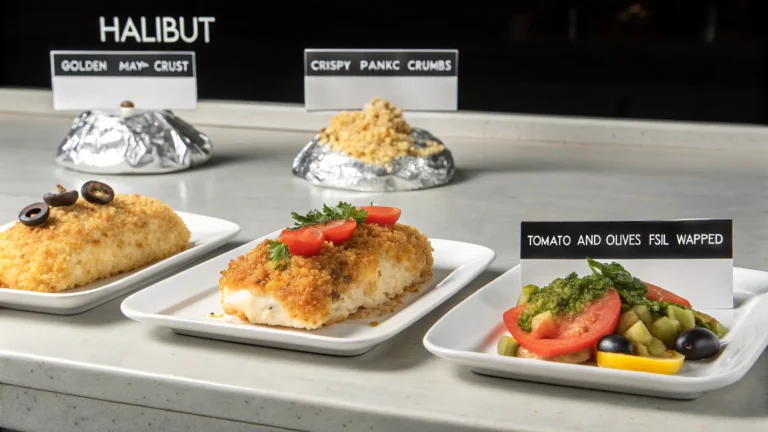
The beauty of this baked halibut recipe lies in its adaptability. Whether you’re working with dietary restrictions, pantry limitations, or just personal preferences, there’s a version here for you. Below are flavor-packed variations that cater to common Google searches — and real-life cravings.
1. Baked Halibut with Mayo Crust
Mix 2 tbsp of mayo with a pinch of cumin, paprika, garlic powder, and lemon juice. Spread over the halibut before baking.
Moroccan twist: add a dash of ras-el-hanout or harissa paste to the mayo for bold heat.
2. With Garlic-Butter Sauce
Melt 2 tbsp butter, add minced garlic, chopped parsley, and lemon juice. Drizzle after baking for rich, glossy flavor.
Pro tip: Infuse butter with preserved lemon zest and cumin for Moroccan flair.
3. With Panko or Bread Crumbs
Mix panko with olive oil, paprika, garlic, and grated lemon zest. Press gently over the fillet before baking for a golden crust.
Upgrade: mix in chopped parsley and a tiny pinch of cinnamon for a unique finish.
4. Without Lemon
Don’t love lemon? Swap it with:
- Preserved lemon (less acidic, more umami)
- Splash of white wine vinegar
- Greek yogurt mixed with sumac or cumin for tang
5. With Capers, Olives, and Tomatoes
Mediterranean-style toppings like briny olives, salty capers, and cherry tomatoes roasted alongside halibut create a juicy, vibrant tray bake.
🇲🇦 Moroccan take: add preserved lemon and a drizzle of argan oil for smoky depth.
6. With Sour Cream or Yogurt
For a creamy finish, mix sour cream or Greek yogurt with garlic, lemon juice, and mint. Spoon over the halibut after baking.
Pairs great with couscous or roasted eggplant.
Can I combine these variations?
Yes, totally.
This recipe is modular. Try panko crust + mayo base, or garlic butter + caper topping. Just avoid overpowering the fish — halibut is delicate and deserves balance.
What to Serve with This Moroccan Baked Halibut
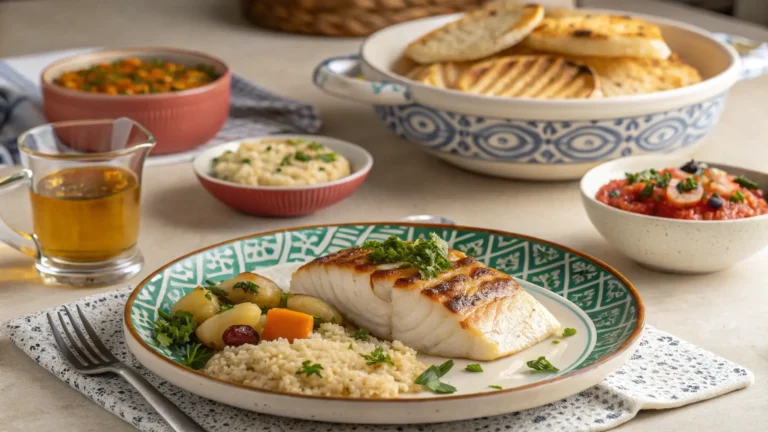
Once your baked halibut recipe is golden and flaky, you’ll want sides that complement its bright, spiced flavor without stealing the spotlight. Moroccan cuisine is full of simple, rustic dishes that pair beautifully with seafood — and many of them use pantry staples most Western kitchens already have.
Here are my favorite sides that make this dish shine:
1. Herbed Couscous with Olive Oil & Lemon
Fluffy couscous tossed with chopped parsley, olive oil, and a squeeze of lemon (or preserved lemon). Quick, light, and ideal for soaking up fish juices.
Shortcut: Use boxed couscous, add cumin and paprika to the water, and fluff with a fork.
2. Zaalouk (Moroccan Eggplant Dip)
Smoky eggplant mashed with garlic, tomato, olive oil, and paprika. Serve warm or cold with flatbread or on the side as a flavor-packed contrast to the halibut.
Western-friendly version: roast eggplant slices and mash with canned tomato + garlic powder.
3. Roasted Potatoes with Harissa & Garlic
Crispy potatoes tossed in olive oil, garlic, cumin, and a dollop of harissa before roasting. The spicy kick balances the mellow fish beautifully.
4. Green Salad with Mint Yogurt Dressing
Crisp romaine or arugula with a tangy dressing made of Greek yogurt, lemon, chopped mint, and olive oil. Refreshing, cooling, and easy to prep ahead.
5. Warm Flatbread or Pita
To mop up all the lemony, spiced halibut sauce. Toast lightly, drizzle with olive oil, and sprinkle a touch of za’atar if you have it.
Can I make these sides ahead of time?
Absolutely.
Most of them — especially couscous, roasted potatoes, and zaalouk — keep well for 1–2 days in the fridge. Just reheat and refresh with herbs or olive oil before serving.
Author’s suggestions
Fried Cod Fish Recipe
baked mahi recipe
Best Moroccan Fish Recipes-Spiced Salmon
Easy Baked Mahi Mahi Recipe Moroccan spices
Nutrition Information & Smart Storage Tips
Understanding what’s on your plate matters — especially when you’re balancing flavor with wellness. This baked halibut recipe is naturally healthy, low in carbs, and packed with lean protein and heart-healthy fats. Plus, it’s meal-prep friendly if you’re planning ahead. FDA Fish & Shellfish Nutrition Guide
Nutritional Breakdown (Per 6 oz Halibut Fillet + Marinade)
- Calories: ~320 kcal
- Protein: 35–38g
- Fat: 18g (mostly from olive oil and fish)
- Carbs: ~2g (from marinade & garnish)
- Sodium: ~300mg (depending on salt and preserved lemon)
Note: Values are approximate and can vary based on fillet size and toppings.
Storage Tips
How to Store Leftovers:
- Let halibut cool fully.
- Transfer to an airtight container.
- Store in the refrigerator for up to 3 days.
Reheating:
- Reheat in a 300°F (150°C) oven, covered with foil for 8–10 minutes.
- Or microwave gently at 50% power for 1–2 minutes.
- Add a small splash of olive oil or lemon juice before reheating to restore moisture.
Can I freeze it?
You can — but halibut’s delicate texture may slightly change. If freezing, do it immediately after baking. Wrap tightly and consume within 1 month for best quality.
Is this recipe keto or paleo-friendly?
Yes!
As long as you skip the panko or breading variation, this halibut dish is both keto and paleo compatible. It’s low in carbs, rich in healthy fats, and fits most clean-eating plans.
A Dish That Brings Two Worlds Together
The first time I baked halibut this way — layered in cumin, preserved lemon, and a little harissa heat — I didn’t expect much. It was a quiet Sunday, I was experimenting with flavors from my childhood, and I honestly thought it would be “too much” for such a mild fish.
But when it came out of the oven, tender and fragrant, and I took that first bite… something clicked. It wasn’t just a good dinner — it was comfort. It was my mother’s kitchen in Casablanca, meeting my modern pantry in the States.
This baked halibut recipe has since become one of those dishes I revisit often — when I want ease, when I want to impress, or when I just miss home a little. It’s simple, flavorful, and full of quiet surprises.
If you try it, I’d love to hear how you made it your own — whether you leaned into the spice, added your own twist, or paired it with something unexpected.
Thanks for cooking with me today. And remember: sometimes the most memorable meals start with a humble piece of fish and a story worth retelling.
Frequently Asked Questions About This Baked Halibut Recipe
Can I use frozen halibut for this recipe?
Yes, but make sure it’s fully thawed and patted dry. Excess moisture dilutes the marinade and prevents proper roasting. Thaw in the fridge overnight or under cold water for quicker use.
How do I know when halibut is fully cooked?
The fillet should be opaque and flake easily with a fork. For precision, use a thermometer — aim for 135–140°F (57–60°C) internal temperature. Don’t overbake; halibut dries out fast.
Is this recipe gluten-free?
Yes — as long as you avoid panko breadcrumbs or use a gluten-free alternative. Everything else is naturally gluten-free, including the spice blend and preserved lemon.
Can I grill the halibut instead of baking it?
Absolutely. Just make sure the grill is clean and well-oiled. You can wrap the fish in foil or grill it directly over medium heat for about 3–4 minutes per side.
What can I substitute for halibut?
Try cod, sea bass, grouper, or even salmon. These fish have a firm texture that holds up well to Moroccan spices and baking temperatures.
How long can I store leftovers?
Store cooled halibut in an airtight container in the fridge for up to 3 days. Reheat gently in the oven or microwave with a splash of olive oil to avoid drying it out.
I don’t have ras-el-hanout — is it necessary?
No, it’s optional. But if you want that Moroccan edge, mix ½ tsp cinnamon + ¼ tsp ginger + pinch of allspice — it’s not exact, but it gets close.
Disclaimer: This content is intended for informational purposes only and should not be considered a substitute for professional medical advice, diagnosis, or treatment. Always seek the guidance of a qualified healthcare provider with any questions you may have regarding a medical condition.
Did you make this recipe?
There are no reviews yet. Be the first one to write one.

